

Reliability that counts

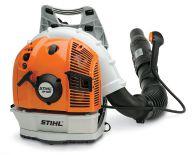
DO MORE IN LESS TIME.
The impressive BR 600 is our number one selling backpack blower across the country…and for incredible reasons. It delivers a powerful performance with a strong air throughput for demanding cleaning tasks. Cleaning walkways, parking lots, stadiums, lawns and parks of leaves and debris will be completed efficiently and quickly. STIHL’s innovative 4-MIX™ engine provides outstanding performance, fewer emissions, more power and less fuel consumption. Its simplified starting procedure provides maximum productivity, its ergonomically designed to reduce vibrations and increases comfort with the dual-adjustable shoulder strap and easy-grip throttle with cruise control. The BR 600 has everything a PRO needs!
PRO-FLEET COMMERCIAL LANDSCAPE PROGRAM
STIHL’s Pro-Fleet Commercial Landscape Program is designed to provide commercial landscapers a volume discount on major purchases of five or more landscaping power tools. Visit your STIHL Dealer today to find out more and take advantage of the savings!



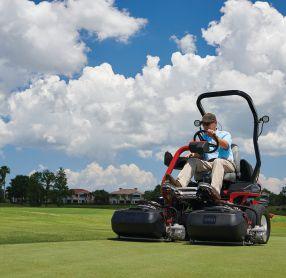

DEPARTMENTS
Huge geese populations creating
in Canadian parks and fields
Industry innovators
recommends max sports turf usage
JIGGENS
JESSE BENELLI

By Mike Jiggens
Shuttering Ontario golf a huge mistake
By the time you read this editorial, the issue I’m addressing may already be a moot point. That’s what I’m counting on, actually.
Nevertheless, this needs to be said.
Ontario’s Ford government committed a huge error in judgment on April 16 when it announced that golf courses were to immediately close their doors and not reopen until at least May 20. This was part of an added measure aimed at curtailing the spread of COVID-19 and its variants. Only a couple of weeks earlier, the province had introduced a new 28-day stay-at-home order as a means of controlling people’s movements. Golf, however, wasn’t part of the original order, and courses were opening left and right for an earlier-than-normal start to the season due to spring’s early arrival.
The consensus from within the golf community was that the provincial government left golf alone in its initial stay-athome order because it understood just how safe the game could be played. No outbreak of any kind was reported to have originated from an Ontario or Canadian golf course in 2020, nor had anything of the sort occurred this year at any of Ontario’s approximately 800 golf venues – many of which had already been open for two to three weeks.
Still, the Ford government felt compelled to lump golf into its one-size-fits-all solution. One would surmise that neither the premier nor any of his advisers play golf or have ever visited a golf course. If they did, they would surely realize that golf is tailor-made for this pandemic. Other than walking or jogging, golf is probably the only recreational pursuit that is 99.99 per cent safe when the proper protocols are followed.
It’s an activity that takes place amidst a vast acreage of outdoor space. The very nature of the game allows for no more than four individuals to congregate in any one spot at a time. These groups or four – or fewer – keep well beyond
The Ford government felt compelled to lump golf into a one-size-fitsall solution
the recommended six feet of social distancing from one another, and the nearest group of four is always at least a couple of hundred yards ahead or behind.
Golfers are not touching the flagstick when putting (it’s outlawed), they’re not raking up bunkers (rakes have been stored away since the pandemic began), they’re not washing their golf balls (ball washers are out of service), and they’re not shaking one another’s hand at the end of their round (they know bet-

ter). And, unlike most other sports, each golfer plays his or her own ball. On the golf course, there is no reason whatsoever for a golfer to touch anything other than his own equipment.
Understandably, clubhouses have been shut down for most purposes since the pandemic began or have had limited operations. The need to keep indoor traffic under control is imperative. But this has no bearing on the game itself.
Health officials are shaking their heads over Ford’s decision to pause golf in Ontario. No other Canadian province has shuttered golf this year, knowing full well the benefits of playing golf far outweigh the risks.
It’s important that politicians learn from history. Amid this chaotic and horrendous pandemic, golf has shone in more ways than one. It’s been proven safe, and the industry has experienced a significant rebound in its fortunes. To suddenly and unexpectedly shut it down suggests nothing has been learned.
As I write this, the backlash from the golf community has yet to be fully felt by the Ford government. Less than a day after extending Ontario’s stayat-home order, Ford backtracked on closing playgrounds, yet continued to pin down golf.
Personally, I suspect the golf lockdown won’t go the duration, and common sense will ultimately prevail. This is why this editorial may very well be irrelevant by the time it’s read. Golf may have been back on track long before now. But I needed to get this off my chest.
www.turfandrec.com
Reader Service
Print and digital subscription inquiries or changes, please contact
Anita Madden, Audience Development Manager Tel: (416) 510-5183 Fax: (416) 510-6875 email: amadden@annexbusinessmedia.com
Mail: 111 Gordon Baker Rd., Suite 400 Toronto, ON M2H 3R1
Editor Mike Jiggens mjiggens@annexbusinessmedia.com
National Advertising Manager Rebecca Lewis 519-400-0322 rlewis@annexbusinessmedia.com
Nashelle Barsky 905-431-8892 nbarsky@annexbusinessmedia.com
Account Coordinator Mary Burnie 519-429-5175 mburnie@annexbusinessmedia.com
Group Publisher Todd Humber thumber@annexbusinessmedia.com
COO Scott Jamieson sjamieson@annexbusinessmedia.com
Printed in Canada ISSN 1186-0170
PUBLICATION MAIL AGREEMENT #40065710
SUBSCRIPTION RATES
Published 7 times a year – Jan/Feb, Mar, Apr/May, Jun, Aug/Sept, Oct, Nov/Dec Canada – 1 year $35.00; 2 year $45.00 3 years $55.50 (plus applicable taxes HST 86717 2652 RT0001
Occasionally, Turf and Recreation will mail information on behalf of industry related groups whose products and services we believe may be of interest to you. If you prefer not to receive this information, please contact our circulation department in any of the four ways listed above.
Annex Privacy Office privacy@annexbusinessmedia.com Tel: 800.668.2374
No part of the editorial content of this publication may be reprinted without the publisher’s written permission © 2021 Annex Business Media. All rights reserved. Opinions expressed in this magazine are not necessarily those of the editor or the publisher. No liability is assumed for errors or omissions.
All advertising is subject to the publisher’s approval. Such approval does not imply any endorsement of the products or services advertised. Publisher reserves the right to refuse advertising that does not meet the standards of the publication.


Engineered for rugged durability and equipped with innovative cutting decks, Bobcat ® zero-turn mowers are designed to keep your crews productive and profitable.

Bobcat
Ontario movement calls for province to reopen golf courses
A movement is afoot in Ontario that calls on the Ford government to rescind its closure of golf courses. The premier announced that golf courses were being lumped into a number of outdoor recreational spaces that would have to remain closed until at least May 20. This isn’t sitting well with the golf industry, which reiterates that golf is perhaps the safest outdoor activity that can be pursued during the COVID-19 pandemic. Tee times that had been fully booked, and subsequently canceled, were apt to lead to a massive loss of revenue that would lead to staff layoffs.
Laval bans use of glyphosate as health measure
The Montreal suburb of Laval has become the first Quebec municipality to ban the use of glyphosate, the active ingredient in the herbicide Roundup. Additionally, the city is banning the use of neonicotinoids and the cosmetic use of lawn pesticides. According to the city, the measures are designed to protect human health, pollinating insects, wildlife and natural spaces.
Vancouver field’s reclassification riles soccer parents
Recently reclassified an A field, the soccer field at Slocan Park in East Vancouver is now off limits to a children’s soccer program, forcing youngsters to move to another field 30 blocks away. The decision by the Vancouver Park Board has riled parents. The explanation is that the park – with its newly upgraded classification – is reserved for “official games” only. One disgruntled parent called the board’s decision “bureaucratic idiocy mixed with red tape.”
May 20
the soonest golf can resume in Ontario under the extended stay-at-home order

Huge geese populations creating stir in Canadian parks and fields
Populations of fowl are on the rise in Canada, causing headaches for municipalities in several regions.
In the Montreal borough of Lachine, populations of Canada geese are tripling every year. The amounts of excrement the birds are leaving behind are creating a serious health concern.
In Richmond, B.C., migrating snow geese from Siberia have arrived in the tens of thousands, littering sports fields with massive amounts of their droppings.
The lawn at Parc René-Lévesque was completely covered in mid-April, Lachine Mayor Maja Vodanovic said. So, too, was the sports field at Hugh Boyd Park in Richmond.
Although both municipalities were facing the same problem, their strategies for control differed.
In Lachine, an animal management firm was hired at a cost of more than $50,000 to scare the geese away through the use of loud noises, leashed dogs and remote-controlled cars.
The number of blocks away from the next nearest soccer field
Richmond has found the use of dogs to be ineffective. The city has
also found such visual deterrents as streamers and flags aren’t as effective as they once were as the geese have become accustomed to them and no longer fear them. The city has instead opted to allow turf to grow longer, suggesting geese prefer shorter grass. Lachine’s strategy was to be implemented in mid-April and continue into September. Other Montreal boroughs, including LaSalle and Verdun, are following suit.
Mayor Vodanovic acknowledged the city’s deterrent strategy was only a short-term solution and would simply drive the birds to other locations. She said she hopes both the federal and provincial governments can come up with practical humane methods for keeping geese at bay. Complaints about the numbers of geese in Richmond have actually decreased, in spite of the increase in bird populations. Clay Adams, the city’s communications director, said he suspects that’s because fewer people are frequenting the areas due to the COVID-19 pandemic.
Industry Innovators
By Turf & Rec
Study recommends max sports turf usage
How many hours of play booked for sports fields is too much? The Ontario Turfgrass Research Foundation (OTRF) has announced recent studies have established more accurate recommendations for the maximum number of permitted hours feasible for sports fields before they reach unacceptable playing conditions.
In conjunction with DCS & Associates, the City of Toronto Parks Department and Sports Turf Canada, the OTRF has produced a whitepaper intended as a tool to provide aid to turf managers in explaining the impact of permitted field hours on sports field performance.
Entitled Usage Goals for Winning Sports Turf, the paper’s information helps sports turf managers justify permitted hours to decision makers and other stakeholders.
In order for sports fields to ensure player safety and enjoyment, they must perform at an acceptable level.
One study looked at 24 different irrigated soccer fields in the City of Toronto, representing a variety of sports field classifications. Data was collected on four dates throughout the playing season, to obtain a snapshot of the various conditions throughout the season. Data was collected from different locations on the fields to establish how specific spots performed, based on permitted usage and seasonal weather. The goal was to develop a pass/fail rating system based on specific measurable quality metrics taken from industry standards. These included the percentage of turfgrass cover, the percentage of bare field, and compaction measurements.

Additionally, cultural management records of the studied fields were taken into consideration as they have a significant effect on the fields’ pass/fail rating.
Data was collected from different locations on the fields to establish how specific spots performed, based on permitted usage.
The location of the studied fields in relation to their parking lots was also taken into consideration as the fields often undergo several hours of unpermitted play that is difficult to assess.
One fenced-in field had a final score that garnered a fail rating. It had been used for 978 hours, or more than double the recommended 450 hours. It more accurately reflects the amount of play compared to fields with no fencing, since fields that are not fenced in often have many hours of unpermitted play which affects field quality and performance.
The whitepaper advises all stakeholders adhere to the permitted hours recommendations as listed in the accompanying table, and then consider their own unique situations to justify their needs.
The OTRF reached the following conclusions:
• All permitted hours of
fields should be reviewed with permitting offices as they significantly impact the pass/fail rating of sports fields. Continuing to utilize older recommendations could reduce the likelihood of a field being maintained to a level that is acceptable for its actual usage.
• When considering permitted usage hours, review the location in relation to public accessibility (i.e. parking lots) and ability to reduce non-permitted play (i.e. fences) as this will often have a significant impact to field quality and increase the likelihood of premature fail ratings.
• The cultural management practices of these fields should be an important consideration in determining the number of permitted hours that a specific category of field can withstand. These practices will also take time to complete and may impact the permitted hours of play. For more information, contact the OTRF at info@otrf.ca.
The OTRF supports sports turf research to improve sustainable management of turfgrass in sports field applications through proceeds from fundraising initiatives, charitable donations and annual industry contributions.
Cricket turf maintenance another ballgame
Brampton, Ont. has become the unofficial cricket capital of Canada. By Mike Jiggens
Cricket is considered to be the de facto national sport in at least eight countries of the world. In Canada, the game has traditionally taken a back seat to hockey, baseball, football, soccer and a number of other sports, but it’s popularity is on the rise in this country, and in one city in particular.
Brampton, Ont. is unofficially recognized as the cricket capital of Canada. Currently, the city has 18 cricket fields –seven of which are irrigated and whose pitches are either natural, artificial or jute mat.
Prior to 2018, there were 16 cricket fields in Brampton. Five of the fields were dedicated to the sport with four of them undersized.
Brian Macklin, supervisor of parks maintenance and operations in Brampton and a board member of Sports Turf Canada, spoke in the winter at the virtually-presented Ontario Turfgrass Symposium, about the challenges the city has
faced in growing its cricket program. A large cricket presence had already existed in Brampton, but enthusiasm for the 2019 Cricket World Cup, played in England and Wales, propelled local interest in the sport to greater heights.
Prior to the World Cup competition, Patrick Brown, who was elected as mayor of Brampton in 2018, wished to see a new state-of-the-art cricket and multi-purpose stadium constructed that would allow the city to play host to the 2020 Global T20 Cricket Tournament – Canada’s largest cricket competition. Although the COVID-19 pandemic forced the event’s cancellation, the game’s popularity continued to grow.
As word of the proposed new cricket stadium began to circulate, Brampton’s cricket user groups began to press the city with a number of demands for its fields.
“As we tried educating the people, there was quite a bit of pushback from the user groups and at times they were questioning if we knew what we were actually doing
out there,” Macklin said.
Mowing at a half-inch
The groups’ demands posed a number of maintenance challenges for the city’s parks department, the most notable of which was a request to mow the playing surfaces at a half-inch height.
“This wasn’t just on our irrigated fields, but on our non-irrigated fields as well.”
Previously, the city’s cricket fields were mowed at one inch for irrigated playing surfaces and two inches on fields without irrigation.
“Generally, this was a good height to produce healthy turf,” Macklin said, noting that fields not dedicated to cricket meant having to place an “overlay pitch” between two soccer fields to allow games to be played with sufficient dimensions. The combined soccer fields allowed for acceptable outfield space, but were mowed to soccer standards.
Before adopting the overlay solution, in which a 22-yard-by-10-foot central pitch


Natural turf cricket pitches are mowed right to the ground and sufficiently compacted to satisfy both the bowler and batsman.



strip was placed between side-byside soccer fields, cricket fields were built on whatever land was available. The outer reaches of one of the city’s first fields infringed upon adjacent buildings, producing a tighter field than what cricket players were accustomed to playing on.
“Because cricket takes up so much space, we started developing overlay cricket fields which solved the issue of having this large amount of space required, but we’d have multiple sports on it. In the beginning, it was great for both sides, but it did create quite a bit of maintenance headaches in terms of bringing nets on and off. When soccer was playing, we needed to remove those nets for cricket to play the next day.”
The overlays, which were either artificial turf or jute mats, represent the central part of the field between sets of wickets, where the bowler faces the batsman.
By 2018, Brampton’s user groups were growing, and the city’s cricket leagues were forced to turn people away because of insufficient facilities. Not only did the groups want the existing undersized fields upgraded, they wanted natural turf pitches installed as well.
Between the demand for natural turf pitches and a field mowing height of a half-inch, the sport was beginning to outweigh the needs to produce healthy turf, “and we were going to have some drastic changes made to our maintenance program,” Macklin said. “We knew that cutting them lower would have an impact on our turf maintenance program.”
Cutting cricket fields at a halfinch would not only have a bearing on plant health, it would increase costs for operations and capital equipment, he said, adding it would require more homework to learn about the various implications.
Brampton’s cricket fields had primarily been grown to Kentucky bluegrass with some perennial ryegrass and fescue mixed in. But, Kentucky bluegrass doesn’t fare well when mowed below an inch, and, in order to move forward, Macklin said new bluegrass dwarf varieties that could withstand shorter cuts were adopted.
The newer varieties cost more, he said, but, “I think the price is worth it. I don’t think we’d be able to do it with what we had before.”
Macklin relied on advice from
“In terms of keeping up with that, we were going to need three new mowers above what we currently had, as well as three operators to run these mowers and keep on top of things so that we’re not allowing that turf plant to get beyond that quarter-inch of growth.”
Each turf species has an optimal range of height, and when mowing heights decrease outside of that range, it results in decreased turf density, a reduction in photosynthesis and a decrease in root growth. Macklin acknowledged

We knew that cutting (fields) lower would have an impact on our turf maintenance program
the University of Guelph and data from National Turfgrass Evaluation Program (NTEP) trials to make the best possible selections.
New equipment needed
The dramatic changes in mowing height would have an impact on the city’s equipment needs. Brampton’s existing reel mowers could cut only as low as three-quarters of an inch to an inch. Newer mowers that could cut at a half-inch would be needed, and mowing would have to be done more frequently in order to achieve the recommended shearing of only the top one-third of the leaf blade.
“If you have a shorter grass blade that’s only half an inch and you have a quarter of an inch that you’re damaging, there’s not going to be a whole lot of healthy plant left.”
Up until 2018, when mowing was done at one and two inches, irrigated fields needed to be cut again when the turf reached 1.5 inches while non-irrigated fields were subsequently mowed when blades grew to three inches.
that once Kentucky bluegrass roots decline, there is less water uptake and an increase in disease and weed pressures, requiring more inputs and more budget.
Kentucky bluegrass is prone to thatch buildup and opens the door for annual bluegrass invasion when it’s cut so low.
Not being able to use traditional chemical pest control products means having to manage disease, weed and insect pressures through increased cultural practices, thatch management, improved drainage, water management, proper fertility and the delivery of a quality cut. When playing host to national or international events, however, the city can apply for a pesticide spraying permit.
The city is looking to adjust its fertility program to adapt to the lower height of cut. Previously, 4.5 pounds of nitrogen were applied to irrigated fields and 2.5 pounds on non-irrigated fields. Because the plant is undergoing greater stress at its lower cut, more applications may be considered, Macklin said.

Implementing natural turf pitches is an altogether different challenge, he said. It involves packing down a baseball mound-type clay, seeding it to perennial ryegrass and mowing it right to the ground once it starts growing. It produces a hard, brown-coloured
21_0738_Turf_Rec_APR_MAY_CN Mod: March 16, 2021 10:45 AM Print: 04/16/21 2:26:16 PM page 1 v7

surface that is conducive to the bowler and batsman. Multiple pitches can be produced for dedicated fields, allowing a new one to be game-ready while the others have time to regenerate. Natural turf pitches were earmarked for five fields.
In order the meet the stringent demands of the cricket-playing community, Macklin said the city needed more employees and additional equipment. Council approved a request for more than $800,000 in capital expenditures and another $350,000 in operating expenses.
The capital expenses included five trucks, three outfield mowers, three rollers, three trailers and two pitch mowers, as well as the cost of natural pitch construction.
The $350,000 operating budget covered eight staff as well as the cost of water, fertilizer, seed, topdressing materials and reel sharpening.
As the city looks toward the future, plans are to increase the number of irrigated cricket fields, replace jute mats and better educate user groups.


A bowler faces down a batsman in a cricket contest.
Bad weather, COVID fail to stop golf work
Burlington Golf & Country Club succeeds with new irrigation system, greens reconstruction.
By Mike Jiggens
Between poor weather in the late stages of 2019 and the beginning of the COVID-19 pandemic in early 2020, a major renovation project at the Burlington Golf & Country Club was hit with a formidable one-two punch. But the resilience of all parties involved – in spite of the setbacks – led to both the project’s eventual completion and its success.
Dean Baker, superintendent for the past seven years at the Stanley Thompson-designed private course along Ontario’s Golden Horseshoe, shared the story of the project’s trials and tribulations via an online presentation in January to members of the University of Guelph’s Turf Club. The work marked the completion of a long-range plan that was devised in 2006 between the club and architect Doug Carrick. Specifically, the project entailed the installation of a new irrigation system along with the reconstruction of three holes, the building of a few new tees and some bunker work.
“As a small, good walking Stanley Thompson golf course that was built a long time ago (in 1922), it was never built for the amount of rounds that we do now, which is on average about 35,000 a year,” Baker said.
Greens are the first thing on a golf course to suffer from wear, he said, adding that by expanding those deemed most prone to continued diminishment, they could better withstand the increased amount of traffic. Consequently, the fifth, sixth and 17th holes were redone.
Work began in earnest in 2019, but poor weather in November and December stalled the project until the spring of 2020. The unexpected arrival of the COVID-19 pandemic in March, however, threw a second wrench into the works, and resumption of the project was delayed yet again due to provincially-mandated work

stoppages. The unanticipated delays set completion of the project back by about six weeks. Prior to the declaration of the pandemic, it was suspected the project was only about four weeks behind schedule.
The reconstruction of the 17th hole located next to the Bay of Hamilton involved the relocation of an adjacent irrigation pond. Not only was the entire fifth hole renovated with the repositioning of its green, its tees underwent significant work, and the entire par three sixth hole was redone. Tee work was also done at the seventh hole, and the club’s driving range complex underwent some modifications.
The club hired FlightLine Golf as its contractor for the renovation work. Baker said he had previously worked alongside the company when he was superintendent at Oakville’s Glen Abbey Golf Club and praised FlightLine president Spencer Adams for his
The 17th hole at the Burlington Golf & Country Club was reconstructed while the adjacent irrigation pond was relocated.

keen attention to detail.
All three of the new greens were built to USGA specifications.
SODDING AFTER POLAR VORTEX
Burlington’s greens had previously been sodded to bentgrass following the winter of 2014-15. A polar vortex system that year left the greens encased in ice for a prolonged period of time, killing the former poa annua surfaces. The new bentgrass greens were ready for play 10 weeks after sodding during the 2015 season. With that experience still fresh in his mind, Baker said he felt confident that another sodding project would see the new greens ready to play within the same time frame.
Before choosing to sod, however, the club’s membership was presented with the cheaper option of seeding the new greens.
“They didn’t even blink an eye,” Baker said when the club chose the more expensive option of sodding.
But with COVID-19 pushing back the construction
time line, it meant most of the sodding work had to wait until June and July – a time of year most superintendents wish to avoid for laying sod. Adding to the challenge of sodding at that time was the extreme heat experienced last summer, with 41 days topping the 30-degree Celsius mark and with scarcely any precipitation. In spite of the heat, drought and high amount of traffic during the summer, the situation presented a silver lining.
Baker said the lack of soft and muddy conditions allowed the sod to go down quicker, and the newly installed irrigation system provided the right amount of coverage. As the project progressed, the new greens started to present themselves as “eye candy” to Burlington’s members, who were anxious for the green light to begin playing on them.
“It was so nice to see green grass as opposed to dirt,” Baker said.
More than 700 skids of sod were laid to complete the renovated holes. He said the new irrigation system proved to be a “savior” during the extreme summer heat, yet a few areas managed to be missed.
Knowing that the club wishes to eventually redo all of its bunkers, he said the project gave him the opportunity to test some liner possibilities for the bunkers that were part of the renovated holes. He opted for a matting-type material, and some of the cavities were filled with Pro/Angle sand.
The club replaced its 30-year-old Toro irrigation system with a more modern Toro product under the supervision of consultant Gary Taylor of GT Irrigation Services. With no interruption of golf, the installation of the new irrigation system gave members a chance to see the work being done.
“Members aren’t used to seeing construction, and when they see this they wonder how long it’s going to take to clean up, but the next day you come back and this eight-inch mainline has disappeared and everything’s clean. The system so far has been running beautifully.”
‘It was so nice to see green grass as opposed to dirt’
Baker said it was a good learning experience for the club’s members, who witnessed how quickly things can get done with both the irrigation installation and construction. After only five or six weeks, it was hard to tell that work crews had been at the golf course, he said.
Moving the irrigation pond at the 17th hole meant having to drain it prior to renovating its intake, and Baker wanted to participate in the task in a hands-on manner. With the pond empty, the club temporarily pumped water from the adjacent bay, but the effort proved futile as a result of continuous clogging. Assistant superintendent Ryan Maragoni spent much of his
Visit one of these participating Exmark Dealers to learn more about the full line of professional Exmark models.
ALBERTA
CALGARY
DRAYTON VALLEY
EDMONTON
EDMONTON
RED DEER
ALBERTA FOREST & GARDEN
HORIZON FOREST AND GARDEN LTD
ALBERTA SMALL ENGINE ...........
403-248-0878
780-542-4446
780-944-9559
EDGE EQUIPMENT LTD .............. FUTURE AG INC
780-455-3343
403-343-6101
BRITISH COLUMBIA
ABBOTSFORD .
CAMPBELL RIVER
CHILLIWACK
COURTENAY
KAMLOOPS
KELOWNA
SURREY
MANITOBA
ALTONA
HEADINGLY
WINNIPEG
FORESHORE EQUIPMENT AND SUPPLY
C & L SUPPLY (1988) LTD ............
604-744-0547
250-287-9231
CHILLIWACK OUTDOOR POWER EQUIP
PILON TOOL RENTALS 1972
B & L SMALL MOTORS LTD
SAVOY EQUIPMENT ................
ARCOM POWER EQUIPMENT INC ......
FRASER VALLEY EQUIPMENT LTD
ALTONA FARM SERVICE LTD
HEPBURN ENTERPRISES INC
ABC POWER TOOLS
NEW BRUNSWICK
IRISHTOWN
ONTARIO
ARVA
AYR
BARRIE
BRADFORD
BRAMPTON
BRANTFORD
BRODHAGEN
BURLINGTON
CHATHAM
SMALL ENGINE HOSPITAL ...........
604-792-4410
250-338-5361
250-376-0033
250-868-1010
604-533-0081
604-590-1433
204-324-5523
204-889-3392
204-224-1760
506-854-2807
HURON TRACTOR LTD ...............
AYR TURF & TRAC LTD
MERCER EQUIPMENT INC
BRADFORD RENTAL SALES & SERVCE
GREEN TRACTORS INC ..............
BOBCAT OF BRANTFORD INC .........
B & K TIRE AND BATTERY
B.R. DICKSON EQUIPMENT INC
CHATHAM OUTDOOR POWER .........
BRUCE SERVICE SALES & RENTALS ....
MAPLE VALLEY SALES & SERVICE
DNR OUTDOOR POWER EQUIPMENT
MARTIN’S SMALL ENGINES LTD
CAMPEAU OUTDOOR POWER EQUIP. ...
519-666-2300
519-632-9901
705-503-3535
905-775-7101
905-846-2511
519-752-7900
519-345-2248
905-331-5040
519-354-3990
519-363-6345
705-466-3138
519-683-6963
519-669-2884
519-727-5031
FEATURE
time standing in the water while keeping the screen clean.
“He might as well have put a bunk down there,” Baker quipped.
THE GOOD, THE BAD AND THE UGLY
The 2020 season featured “the good, the bad and the ugly,” he said, adding, “It was probably one of the toughest years I’ve gone through as a superintendent.”
The “bad,” he said, was more of a challenge than anything else. When work was paused due to poor weather in late 2019, the thought of a spring health crisis was the furthest from anyone’s mind. COVID-19 not only pushed construction further back, it delayed the golf course’s spring opening by a full month. But golfers returned in droves by the middle of May.
“We set records, even opening a month late, on the amount of rounds we did.”
Baker cited the “ugly” part of the project as its impact on his staff.
“Trying to go through this every day was a challenge in itself,” he said, noting he was haunted by his own “witching hour” between 4 a.m. and 6 a.m. when he found it difficult to fall back asleep. There were times he didn’t want to get out of bed to face the day, but having a solid support team behind him – starting with his wife, who offered continuous encouragement – convinced him he could successfully complete the project.
“When you’re going through it, it’s extremely hard, but the good thing is once you get through it you can put a smile back on your face and say, ‘We made it.’”
The “good” aspect of the project was that Baker, his staff and contractors completed the project “with flying colours,” much to the satisfaction of Burlington’s members.
“We got through this successfully because we had a plan from the get-go which we stuck to.”
Baker praised Carrick for his vision of the finished product. With the aid of computer-generated flyover photography, members could see what the golf course was going to look like before the first shovel went into the ground.
“That was a huge asset.”

EXETER
FERGUS
HAMILTON
HANOVER
MISSISSAUGA
MITCHELL
MOUNT FOREST
NORTH YORK
PETERBOROUGH
SCARBOROUGH
SUDBURY
THAMESFORD
VARS
WINDSOR
HURON TRACTOR LTD
A.S.E. EQUIPMENT & CARTWORLD
OUTDOOR SUPPLIES & EQUIPMENT
BRUCE SERVICE SALES & RENTALS ....
ZEHR’S SALES & MANUFACTURING ....
WPE LANDSCAPE EQUIPMENT
W.E. ENTERPRISES LTD
MITCHELL CYCLE INC
BROADLINE EQUIPMENT LTD .........
PRICELESS PRODUCTS LANDSCAPE
M.C. POWER SPORT
MCGILL EQUIPMENT
SUDBURY SMALL ENGINE ...........
HURON TRACTOR LTD
M.R. BLAIS SALES & SERVICE INC
VEHICLE VENTURE
519-285-3845
519-820-9708
905-578-2411
519-364-6345
519-595-7579
905-569-2055
905-629-1424
519-348-0490
519-323-3591
416-410-2158
705-748-5189
416-751-4455
705-564-9772
519-285-3845
613-443-1230
519-966-8642
Baker and Taylor are both well experienced in the field of irrigation and knew where every sprinkler was going to go. The contractor was also picked a year in advance of the project. Having lost his three senior managers to other opportunities a year before the project’s start, Baker had little time to build a new team. But he applauded his staff’s efforts and noted the success of the project was largely due to everyone’s resilience.
“One of the biggest things that help us in this and why resilience comes to us every day is called Mother Nature, or the weather.”
Dealing with Mother Nature can be unpredictable at the best of times, but she is the main reason why golf course maintenance workers are naturally resilient, he said.
“That gives us more strength to deal with all kinds of challenges. We keep on kicking along, even when times get rough.”

For a variety of reasons, the diesel-powered Lazer Z® zero-turn mowers may be the right choice for your cutting needs. These machines make quick work of the largest, toughest jobs and raise the bar for cut quality, operator comfort, fuel efficiency and ease of handling. The recently updated 96-inch Lazer Z Diesel is the largest, most powerful Lazer Z model. Capable of mowing in excess of 9.5-acres per hour, the 96-inch flex wing deck model is the most productive diesel mower Exmark has ever built. The Lazer Z Diesel is also available with 60- and 72-inch UltraCut™ mower decks.
Learn more at Exmark.com

FIND YOUR LOCAL EXMARK DEALER
Dr. Jesse Benelli is with
Chinch bugs pose big problem in 2020
The No. 1 insect pest during 2020 in residential lawns was the hairy chinch bug
By Dr. Jesse Benelli
Move over Japanese beetles. Step aside European chafers and all other scarab beetles. Undoubtably, the No. 1 insect pest during 2020 in residential lawns was the hairy chinch bug.
Individually, they are small, minuscule surface feeder pests. Their power lies in their numbers, and in 2020 it felt like their populations exploded. Left in their wake were merely the unrecognizable remains of what once were beautifully manicured lawns.
What happened? Why was 2020 so extraordinary for chinch bugs? Will it happen again? This article hopes to shed light on these questions as we put 2020 in the rear-view mirror and begin the growing season of 2021.
BACKGROUND
History and distribution. Chinch bugs are native to North America and are found across most regions of Canada, the United States and Mexico. The term “chinch bugs” is a generalized name that groups together all species of this pest. There are several different species of chinch bug that reside in different geographic regions. Hairy chinch bug (Blissus leucopterus ) is the dominant species in Eastern Canada. In Western Canada, the dominant species may be the western chinch

bug (Blissus occiduus).
Identification. First instar nymphs are orange with a beige stripe that runs horizontally across the mid-section. More importantly, first instar nymphs are incredibly small, with most of them being just under one millimetre in length. As nymphs mature in size, the orange colour gradually gives way to more of a dark
brown to grey appearance. It is not until the fifth instar stage when wing pads are fully distinguishable and the overall colour of the chinch bug is black.
Lifecycle . In the spring, chinch bug adults migrate into lawns to begin feeding and mating. Females lay eggs when daytime temperatures exceed 15 degrees Celsius. For most regions in Canada,
Close-up of an adult chinch bug on a leaf.
eggs will hatch in early-to-mid June, depending on the weather. Chinch bugs will complete five nymphal stages before maturing into adults by mid-to-late August. In years with sustained heat, a second generation can begin, but these second-generation nymphs will not successfully overwinter into the following year.
Feeding. Nymphs and adults have piercing-sucking mouthparts that injure turf by withdrawing sap from leaf, sheath, crown and stem tissues. During feeding, chinch bugs inject salivary toxins into the plant, causing coagulation within stem and leaf tissue, which affects the plant’s ability to transport water and nutrients.
Damage. Initial symptoms of chinch bug feeding include reddish purple discolouration of the leaf blade margins. As damage progresses, the affected leaves turn yellow, and thinning can be observed. As feeding intensifies, plants begin to turn straw colour and do not respond quickly to irrigation or fertilization inputs. If left untreated, large swaths of turf will decline and death can occur. Plants grown on south-facing slopes that receive full sun are at most risk of decline.
Scouting . Chinch bugs are most active during the early afternoon hours when it is sunny and warm. Adults can be seen in the spring on grass blades and nearby structures such as patios, decks, foundation walls, and fencing. Nymphs are much harder to see, and will be present from mid-to-late June through August. Nymphs tend to feed very close to the base of the plant stem. In late spring and early summer, it is important to get close to the ground and peel away the thatch material to scout for chinch bug nymphs.

WHY WERE CHINCH BUGS SO DEVASTATING IN 2020?
High number of overwintering adults. The summer of 2019 brought well above-average temperatures for much of Ontario, Quebec and the Maritimes. This weather was very conducive for the proliferation of chinch bugs. In correspondence with several lawn care operators, the summer of 2019 was (at the time) the worst year for chinch bugs in more than a decade. This likely resulted in very high populations of chinch bugs that overwintered heading into the 2020 season.
Late spring warmth accelerated egg laying and egg hatch. Air temperatures throughout Eastern Canada started off well below average in early spring. However, this soon gave way to record-setting warmth by the end of May. Hot and dry weather accelerates all aspects of their behavior and lifecycle. The timing of the record-setting heat during late spring couldn’t have been more perfect for accelerated egg laying, egg hatch, and an explosion of chinch bug nymphs.
Dry weather increased chinch bug survival. In 2020 hot weather was met with moderate to severe drought in parts of Eastern Canada. Chinch bugs will proliferate more readily in conditions of low soil moisture. In addition, low soil moisture can diminish the natural spread and infection of the pathogenic fungus Beauveria bassiana . Furthermore, researchers
LOADS
Best of all, these machines are backed by Brandt; the best-trained and most committed 24/7 after-sales support team in the business. That’s Powerful Value. Delivered.
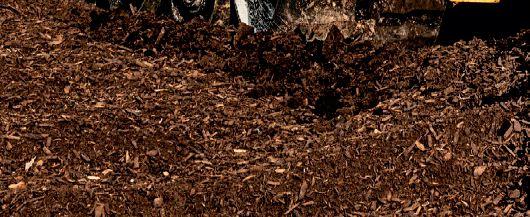
recognize that flooding rains during spring can “drown out” chinch bug eggs and nymphs. Unfortunately, those flooding rains never happened. Undoubtably, the hot and dry weather caused not only higher populations of chinch bugs, but also inhibited many factors that lead to natural death of the chinch bug population.
Summer turfgrass decline was also a culprit. Many of our cool season turfgrasses reach peak physiological condition when mean air temperatures are between 18 and 22 degrees Celsius. The turf also needs adequate sunlight, nutrients, and water, the latter of which became increasing hard to come by during the season. Keeping the lawns adequately hydrated during the 2020 season was exceptionally difficult, if not impossible. This resulted in an already exhausted turf system having to endure a fight for its life. And in 2020, the chinch bug won.
Control solutions may have been applied too late. The warm and dry weather in May and June accelerated the lifecycle and behavior of chinch bugs. Being just two weeks late on an insecticide spray could have huge ramifications on achieving satisfactory chinch bug control.
Chinch bug populations can increase rapidly during the first five weeks following initial egg hatch. Studies in Ohio have reported that first instar nymphs showed population increases from 25 to 60 times in the two weeks following initial appearance.
This means that their nymphal populations can literally double each day soon after hatch.
If you have seen unsatisfactory results using registered insecticides, it may be worthwhile to review sprays records. Some applications have been applied too late to achieve optimal control of nymphs.

WHAT CAN WE DO DIFFERENTLY IN 2021?
Chinch bug infestations have been an emerging problem across residential areas for the last decade. In 2019 and 2020, chinch bugs haven’t just emerged, they have cemented themselves as the biggest insect-related challenge for homeowners and lawn care companies that try to control them. In developing sustainable chinch bug control programs, it is important to utilize the full spectrum integrated pest management (IPM), including cultural and chemical remediations.
Scouting and monitoring.
Increasing your frequency of scouting early in the season is the most critical component of a successful IPM strategy. Scout first in areas
close to overwintering habitats that receive full sun. This would be near mulch piles, patio or decking structures, or along fencing or foundation walls. From April through the first half of June the vast majority of chinch bugs that you will see are fully developed adults. From the second half of June through August, chinch bug nymphs will dominate the population.
Scouting for the initial appearance of first instar nymphs is critical. These first instar nymphs can be very difficult to see. They do not tend to be readily visible on sidewalks or high up the leaf base. First instar nymphs are typically found very close to the soil layer near the thatch and plant stem. An effective scouting technique that anyone can use is the modified flush technique.

Z400 SERIES ROLL OUT WITH A HIGH-PERFORMANCE MOWER.

Four years or 750 hours
See a participating Husqvarna servicing dealer for details
Husqvarna’s Z400 series of professional zero-turn mowers is ready to deliver for your commercial operations. This highly productive and efficient lineup is designed for maximum performance and easy serviceability. From an optimal weight balance to the cutting-edge performance of the Parker HTE transmission, each mower in the Z400 series is ready to get the job done faster and more efficiently than ever before. HUSQVARNA.COM
Connect with HusqvarnaCA
Maximizes uptime
Ideal balance and traction
New, highperformance transmission
© 2021 Husqvarna AB. All rights reserved.
A modified flush technique requires the use of a plastic or metal cylinder (such as a soup or coffee can) and the removal of both lids of the container. Lightly pound the canister into the ground with a rubber mallet so that the container is approximately five centimetres in the ground. Fill up the canister with water and keep refilling the canister to ensure water isn’t draining too quickly. After 30 seconds, chinch bug nymphs and adults will float to the surface. Count the number of chinch bugs that have surfaced. A common threshold to determine if a spray application is necessary is approximately five to eight chinch bugs per 15-centimetre diameter using a coffee canister. This sampling should be done at several locations within a lawn and replicated weekly to observe trends even after a chemical treatment.
Cultural control.
Fertility . Maintain adequate nitrogen fertility during spring, summer and fall. Lawns deficient in nitrogen will have less energy and have a lower recuperative potential to tolerate chinch bug feeding. Late summer or fall fertilization can be effective in recovering compromised lawns.
Irrigation. It is important to irrigate lawns to prevent wilt stress during the summer months to prevent further turfgrass decline. Turf grown on south-facing slopes in full sun may require more water than areas grown in shade.
Overseeding . Introducing endophyte-enhanced grasses will improve the lawn’s tolerance to chinch bug activity. Endophytes are non-pathogenic fungi that can allow for reduced inputs on residential lawns and can help reduce chinch bug damage.
Mowing. It is best to cut and maintain the lawn at a height of five to eight centimetres during the summer months. It is important to mow at the rate of growth. The rule of thumb is to not remove more than one-third of the leaf tissue when mowing. Maintain sharp blades to prevent a ragged cut that could result in moisture loss and decreased turf quality.
Lawns deficient in N will have a lower recuperative potential to tolerate chinch bug feeding
Biological control . Naturally occurring biological controls have been identified for chinch bug management. The pathogenic fungus Beauvaria bassiana has shown to be able to reduce chinch bug populations. There are several new Beauvaria bassiana-based products that were recently registered by the PMRA. After spreading the biological control agent, the manufacturer recommends keeping the ground well “humidified” to enhance the efficacy and spread. In an active outbreak, these products may need to be reapplied at three-to-five-day intervals.
Chemical control
Effective application timing . Several variations of growing degree day (GDD) models have been developed for Ontario, Quebec and Atlantic Canada. The most common base temperature is seven degrees Celsius. Using this number, peak egg development occurs at 187-340 GDD, and first instar nymphs are observed between 250-500 GDD. Peak damage caused by third and fourth instar nymphs occurs between 500-1000 GDD, which will be from early-to-mid July for most years, depending on the region (see chart). Monitoring the lifecycle of chinch bugs through scouting and monitoring, as well as tracking growing degree days, it is now possible to plan an action plan.
Product selection. Many insecticides and entire classes of chemistries have been banned for residential use. This includes many of the older pyrethoid insecticides (such as bifenthrin) and all neonicotinoids (such as imidacloprid and clothianidin). There are now only two synthetic chemistries that are currently labeled for chinch bug “control” in residential spaces:
• DeltaGard SC is an effective, fast-acting contact insecticide labeled for
control of chinch bugs, ants, cutworms, webworms and ticks. This product should be applied in enough water volume to achieve deeper coverage into the turfgrass canopy.
• Tetrino is a broad-spectrum systemic insecticide that contains the active ingredient Tetraniliprole for rapid plant uptake and translocation. It provides strong systemic activity for many root- and surface-feeding insects – including chinch bugs and white grubs. Repeat applications at 28-day intervals may be necessary for large chinch bug populations.
Early season timing . For chronic chinch bug infestations, consider a spring adulticide application of DeltaGard SC just prior to egg laying. This application should be made before 200 growing degree days (base seven degrees Celsius) have accumulated. In most years, this application timing occurs in mid-to-late May, depending on the weather. Adding a systemic insecticide such as Tetrino in this application will improve control of spring adults and provide protection against younger nymphs after egg hatch.
Mid-season timing. A sequential application of a DeltaGard and Tetrino and systemic insecticide should be applied when third instar nymphs reach peak activity. This tends to occur in early-to-mid July, when cumulative growing degree days are between 500 and 800 (base seven degrees Celsius). Adding Tetrino at this time provides improved chinch bug control and control of annual white grubs, such as Japanese beetle or European chaffer.
Other consideration s. Applications for chinch bug control should be applied in a sufficient water volume to ensure the spray solution is driven towards the base of the plant near the thatch layer.



MIGHTY CAPABILITY. NIMBLE PACKAGE.
Get mighty capability in a nimble package: the NEW Kubota RTV520 has the power to tow, haul, and perform even in the tightest of spaces. Its powerful 2-cylinder liquid-cooled Kubota gas engine boasts up to 17 HP, giving you the muscle you need to get more jobs done – and have a little fun, too. kubota.ca |

Golf’s battery equipment making strides
Advances in lithium-ion technology are catching golf industry’s attention.
By
Mike Jiggens
Agrowing consciousness toward an emissions-free world is being experienced virtually everywhere – in industry, travel and home living. With each passing year, there are more cars on the road that are powered by batteries. Power generation is turning the corner toward cleaner energy, and more and more homeowners are adapting to battery-powered mowers, trimmers and edgers.
Operators of commercial turf equipment haven’t quite reached the point where they’ve entirely swapped out their larger gas-powered machinery in favour of battery-powered equipment, “but we’re going down that road pretty quick,” says Bill Januszewski, fleet manager at Capilano Golf & Country Club in West Vancouver.
Januszewski was among the education session speakers in March at the Canadian Golf Course Management Conference, which was delivered virtually this year amid the COVID-19 pandemic.
“You would have to have a visual impairment if you’ve not seen the proliferation of battery-powered equipment now available,” he said.
Battery power isn’t a new concept, Januszewski said, noting 1890 saw the introduction of the first electric car that was capable of reaching a speed of 23 kilometres per hour. Electric trains were also used to transport coal from underground mines so that their motors could be spared of using precious oxygen.
These early generation vehicles were powered by lead acid batteries. Today, the lithium-ion battery is the preferred choice, having evolved exponentially over the years from its original form. “Not that spectacular” at the outset, the vast improvements made to the lithium-ion battery have enabled it to power everything from a toothbrush to cars, aircraft and ships.
“Virtually every tool that is powered by an internal combustion engine now has a battery-powered counterpart.”
Januszewski said smaller battery-pow-
ered devices are fairly simple, requiring a fully charged battery to be inserted into the item so that it can be operational.
“For a toothbrush, that works OK, but for a commercial-grade, battery-powered rotary mower, there’s a bit more to it.”
Among Capilano’s fleet of equipment are a number of battery-powered tools made by some of the industry’s leading manufacturers. With increased battery use, however, comes the need for increased training, Januszewski said.
“A lot of techs have a tough time with electrical stuff because electricity is one of those things you can’t necessarily see.”
He suggested technicians who aren’t adequately schooled in the troubleshooting and repair of electrical equipment should learn some basics, either at a local technical school or through online training. “Poking around” with a test light, for example, can cause significant damage to the equipment or physical harm to the inadequately trained technician.
“Electrical machines have different
The electric TriFlex mower from Toro is a piece of equipment that has been embraced at the Capilano Golf & Country Club in West Vancouver.
handling requirements and pose hazards that are different than what they’re used to.”
Battery-powered equipment have certain advantages over internal combustion engine-powered equipment. There is no gas and oil to mix or liquid fuel to handle, and there are no combustion gases.
“It eliminates almost all leak points.”
The electric TriFlex mower from Toro is a piece of equipment Capilano has recently embraced. Reels are electrically driven and are lifted and lowered electrically, and the machine’s propulsion is electric. These attributes contribute to decreased vibration, reduced maintenance and less noise. With about 175 neighbours encircling the golf course, a visit from an angry homeowner is almost guaranteed if internal combustion engine-powered equipment is fired up before 7 a.m.
LITHIUM-ION’S DOWNSIDE
The biggest downside to lithium-ion battery-powered equipment right now is cost, Januszewski said, suggesting commercial-grade equipment can be two to three times higher than that of internal combustion-powered equipment. Maintenance shops may also need to upgrade their electrical service to ensure there is sufficient energy available for charging. The shop at Capilano underwent renovations a few years ago, and electrical upgrades were made to address its inadequacy.
Even though lithium-ion batteries are far superior to lead acid batteries, they are subject to aging – even when not in use – and will deteriorate. Januszewski said he figures the technology hasn’t yet fully matured, noting metals and chemicals are changing on a continuing basis. He started experimenting with lithium-ion batteries in 2014 by retrofitting a gas-powered greens mower with first-generation lithium-ion batteries.
“Out of the gate, they were great. After three months, they were useless.”
He turned to second-generation lithium-ion batteries and got 12 months

Heavy duty bolt-on serrated grader blade Floating clod-breaking pulverizer roller
Heavy duty floating levelling bar Floating rear brush with side bumpers Broom and rake holders Adjustable rear brush

TECHNOLOGY
out of them, but then backed away from batteries for a couple of years. Technology has moved forward considerably since then, and today’s third-generation lithium-ion batteries are a vast improvement from their previous generations.
“We can thank Tesla for that because they’re the ones that really invested heavily in lithium-ion batteries to get it to the next level. But it’s still evolving.”
Januszewski said there are still plenty of unknowns associated with lithium-ion batteries, including the risk of fire. The risk of handling a combustible liquid fuel is replaced with the potential danger of dealing with the thermal runaway of a lithium-ion battery. The disposal of large lithium-ion batteries that have reached the end of their life expectancy presents a different hazardous waste stream and one that isn’t cheap.
He said some manufacturers may claim the operating cost of a lithium-ion battery-powered piece of equipment is close to zero. But when using backpack blowers, for example, a cable is needed to connect the backpack to the implement. The cable has a finite life that is often compromised by continuous plugging and unplugging as well as coming in contact with loose sand and grass. The cable costs about $300, he said, making it an operating cost.
BACKPACK BLOWER NOISE
Although most lithium-ion battery-powered types of equipment are quieter than their gas-powered counterparts, operators need to be mindful of backpack blowers, Januszewski said, noting that measuring sound output isn’t as simple as using a decibel meter. Sound involves

three separate elements: amplitude (how loud it is), duration (the length of time one is exposed to noise) and frequency (the noise’s pitch).
“That’s the problem with lithium-ion backpack blowers. They’re much like a jet engine. If you’re looking at the backpack blower, it’s not that noisy. If you’re on the site of it with an operator, it’s not that noisy. If you get behind it, you’re looking for a 747 because it sounds like one’s taking off.”
The ”jet engine-like” sound can be mitigated as long as the operator doesn’t have his back to the homeowner, he said.
Safety is just as crucial in the maintenance of lithium-ion battery-powered equipment as it is with gas-powered tools and machinery. Before beginning any type of maintenance, the unit needs to be locked out. It if has a key, it should be removed and placed in a pocket. If there is no key, the




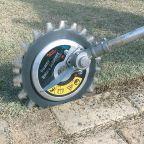





battery needs to be disconnected.
“When the machine is on but not operating, it’s dead quiet and you don’t hear anything until you pull the trigger, and that can be nasty if your finger is in the wrong spot.”
Jewelry worn on the hands or wrists should be removed before any type of maintenance work is done, Januszewski said.
“Rings and watches are great conductors of electricity and can make a real mess if they shorten something out while they’re on your wrist. Your ring could touch a couple of terminals, turn red hot and badly injure your finger. Rings and watches can also catch on equipment –electrical or not.”
As little as 50 volts of electricity will stand a person’s hair on end under the right conditions. Commercial-grade battery-powered equipment exceeds 80
volts. A charger is powered by a line voltage of 117 volts. Januszewski said because it’s alternating current, 117 volts actually works out to be 170 volts. Golf course technicians have been around electrical equipment for a long time, but complacency can still creep in, he warned.
“Handle lithium-ion batteries carefully. Don’t drop them or throw them around.”
Lithium-ion batteries can experience thermal runaway if mishandled. The phenomenon causes a fire that can’t be extinguished and continues until everything in the battery is consumed. Temperatures from the fire can exceed 2,000 degrees Celsius.
Januszewski said the batteries must be charged with a charger designed for lithium-ion and with a power supply that has enough current available for the charger. Extension cords should never be used, he
added.
Lithium-ion batteries consist of a number of single cells that are interconnected to deliver the voltage and current required. The cells are wrapped together and sealed to form a battery. A battery management system at its end works in conjunction with the charger.
Turf maintenance staff at Capilano bring extra batteries with them when tending to their duties. They are transported in a carrier that prevents them from banging against each other and getting wet.
Januszewski recommended the commercial versions of battery-powered equipment be purchased for golf course use, and not those designed for home use. Consumer-type equipment may be only one-third of the cost of commercial-grade versions, but he figures the costs of commercial equipment will one day fall.

DELIVERING SUPERIOR SOD WITH QUALITY SERVICE


#1 Kentucky Bluegrass | Low Mow | Extreme or Tall Fescue | Native or USGA Bentgrass | Large or small rolls
The soil food web is a powerful ally
The soil food web is somewhat hidden and unseen without a shovel or microscope
By Michael Stangl
Istarted applying fertilizer and sprays back in 1981. Over the years I came to understand that the way I managed the soil has an outcome on plant health. I had soil tests done that told me what I needed to apply, and agronomists, manufacturers and other specialists were all willing participants to sell me what I needed.
You know, I, like the planet, was not born last night. It was 55 years ago, but more importantly it was 4.5 billion years ago for the earth. Earth has evolved with tried and tested processes to regenerate life both in the soil and above. All this life is connected by a food web to flourish. The soil food web is somewhat hidden and unseen without a shovel or microscope.
Today’s agronomy of N-P-K is based on Justus von Liebig’s (German chemist) findings from 1840 (all the while other technology has evolved). Liebig reported that the atmosphere did not contain sufficient nitrogen, and that started the industrial wheel of manufacturing artificial manures (fertilizers). Within years, a process of manufacturing munitions and fertilizer was developed in Germany to support its war efforts, called the Haber-Bosch process.
We are just coming to understand what is in the soil, with very recent discoveries, and what is happening just below our feet. For example, we know that there are 74,000 tonnes of nitrogen gas above every







hectare and yet we continue to apply more and more nitrogen at a cost to us and the environment.
I want to break that down for you. A pallet is 48 inches by 40 inches for a total of 13.32 square feet. The one pallet footprint is holding nine tonnes of atmosphere nitrogen that can be converted to N fertilizer by harnessing the soil food web activity 24/7.

We have so much tech in developing fertilizer formulations and delivery systems that cost us to only have a result that requires more. We can take this as part of our job, or we can see this as an opportunity to harness the soil food web in providing the plant needs for every second of the growing season.
Let us get that food web working for you.
The key reason fertilizer works is be -
The soil food web.
Michael Stangl is the owner of Stangl’s Enviro Lawn Care in St. Catharines, Ont.
cause the soil is dirt – compacted bacterial-dominated dirt. With each application, only a portion of what we put on is used (up to 30 per cent), the remainder gasses off or flushes away with watering or those heavy rains into the streams, rivers, lakes (blue green algae blooms/cyanobacteria), and oceans (dead zones, red tide).
The chemistry created by this compacted dirt is designed for weeds to grow. Each fertilizer application forces bacteria to eat even more organic matter, gassing it off as CO2 as well as producing excessive amounts of nitrates that wash away. This signals for plant diversity (weeds) to grow to hold onto these nitrates from moving or further gassing off as ammonia.
Plant diversity’s (weeds) primary reason is to propagate excessive seed counts to grow and die, leaving behind plant debris of root structure that broke the compaction, increased infiltration/gas exchange, scavenged the needed nutrients to bring to the surface to develop and prime the soil food web into building organic matter.
The soil food web is intelligent. Recent data shows that once we get optimal organic matter built within the whole, the food web moves along the transition from compacted dirt into a regenerative soil teeming with life.
Increasing photosynthesic
To further improve a functioning soil food web on a whole, increasing photosynthesis amps up plant exudates that feed greater bacterial and fungal diversity to optimize the food web that contains nitrogen fixers, phosphorus solubilizers and more.
There are simple solutions to start the regenerative process. A light disturbance to the surface area such as aeration to open compaction for greater gas exchange and infiltration should be done yearly and, if budget allows, in the spring and fall. Next apply as many turfgrass species as you can at once. A 12-grass species blend adds to the seed bank as well as being opportunistic. Applying this to the existing areas will create a diversity of exudates for even greater number of species within
the soil food web.
Topdress with a compost (not all compost is the same – results vary) to build up the organic matter that is required for the food web. The regenerative process is so intelligent that the plants will send more than 90 per cent of the sugars it makes from photosynthesis out the roots as exudates to build diverse soil life for organic matter. Once that organic matter percentage is met, exudates reduce, and surface growth increases like it had been fertilized – all with the soil food web.
Adding an inoculant is important and is also simple. Do you buy or make your own? Buying has very few species, is limited and creates unbalance. Using a Johnson Su Bioreactor (JSB) is data driven. It that takes 60 weeks to produce a finished diverse compost that contains up to 2,750 species of bacteria, 400 to 500
species of fungus, protozoa, nematodes and microarthropods.
The JSB is used globally as an inoculant, seed coating and slurry in furrow, foliar, and root feeding. The evidence is clear, and results are proven for lawn, sport field, golf and other applications.
Measuring results with a microscope would provide the needed observation for the evidence/data that can direct what needs to be done next in fine tuning or drastic overhaul.
With some new tools and understanding, regenerative processes can reduce inputs, increase infiltration, resilience, and profits.
If you have questions and need answers, check out “Regenerative Lawn Care” on Facebook (https://www.facebook.com/ groups/1591152457939867). Contact me at info@stangls.com or (905) 641-8133. rom greens, to fairways, to rough; Greenhorizons grows it all. Greenhorizons Sod Farms is Ontario’s leading sod and ground cover solutions company. Family owned and operated since 1975, we are a dedicated team of highly skilled turf specialists.
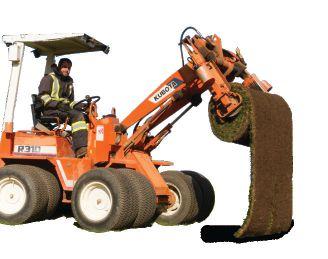


Property types help landscapers decide on equipment needs
Choosing the proper equipment is key to keeping turf at its best
By Nick Minas
When it comes to picking out the right machinery for your operation, choosing the proper equipment is key to keeping turf at its best. That being said, there are a vast amount of property types and there are multiple machines designed to maintain these different grounds.
To help navigate through these various options, we will outline the different types of machines, the benefits of each, and best practices for keeping equipment running all year long.
First, you will need to determine what type of equipment is right for you. It is important to understand what your needs are to help ensure you are selecting the right machine for the job. What specific jobs are you trying to complete? For example, do you only want to cut grass with the machine, or are you looking to complete multiple tasks? Do you need specific attachments?
Two additional factors to consider when choosing a mower include horsepower needs and the terrain of the property on which you will be working. When thinking about machines designed to cut expansive areas of grass, most people opt for zero-turn radius mowers. Designed to
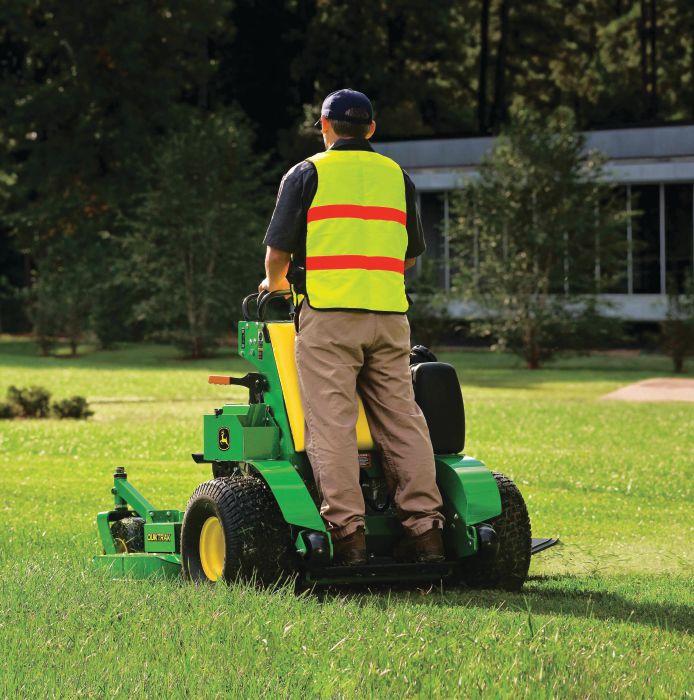


be powerful cutting machines, zero-turn mowers allow the operator to quickly and efficiently manoeuvre through broad areas of grass. These mowers are also efficient in areas with a lot of objects to mow around, such as trees and landscaping.
STAND-ON MOWERS
While zero-turn mowers are more dom-
inant in the market, we have also seen great growth with stand-on mowers. A few factors play into a landscaper’s decision to use a stand-on mower. Stand-ons are ideal for smaller properties and landscapers who want to fit several machines on one trailer. Unlike stand-ons, zero-turn mowers are larger in size and take up more space on a trailer.

Stand-on mowers are ideal for smaller properties and landscapers who want to fit several machines on one trailer.
PHOTO: JOHN DEERE






















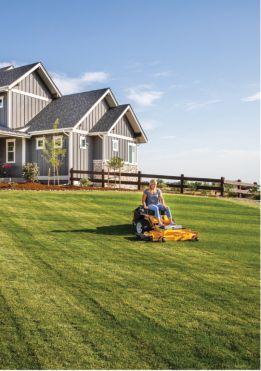

EQUIPMENT
Cost is also a factor, as stand-on mowers are typically less expensive than zero-turn mowers, so budget may be an overall decision-driver as well. The visibility and productivity of stand-ons are some of the other key benefits.


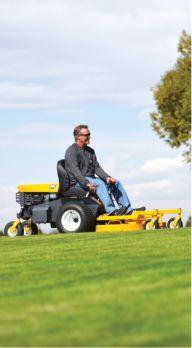





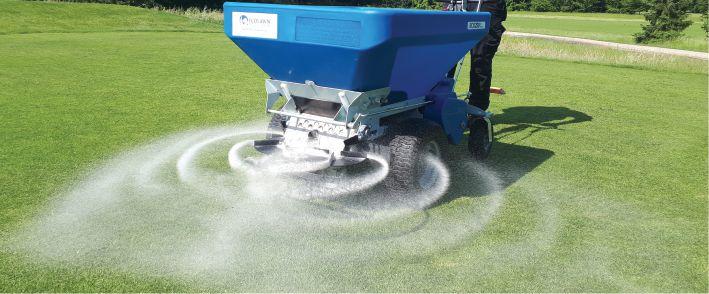


Another mower type worth considering is a commercial walk-behind mower, which are ideal for tight, narrower spaces or smaller yards. Walk-behinds are a great option for an equipment fleet because they are machines that are easy to manoeuvre, are compact and are versatile. Additionally, walk-behinds can tackle a variety of terrains, from hills to flat spaces, giving these mowers an advantage over other machine forms.
Having the right equipment is pivotal to successfully
maintaining grounds
A popular choice for maintaining large acreage properties is a wide-area mower. Equipped with three mower decks, wide-area mowers have a larger cutting width than other machine options, which helps to speed up the total cutting time. Front mowers are also a great solution for larger properties such as parks and recreation facilities, as these mowers combine manoeuverability with the ability to mow lots of grass. One factor that separates front mowers from other mowers is their multi-season capabilities, as these machines can be equipped with attachments to tackle other tasks, such as snow removal, giving owners more bang for their buck.
COMPACT UTILITY TRACTORS
Compact utility tractors have a reputation for being the Swiss army knife of




EQUIPMENT
equipment, as these machines can be transformed using a vast array of implements to tackle just about any task. From mowing and aerating, to blowers, blades, backhoes, and loaders, compact utility tractors are ideal because of the versatility of the machine.
Another important machine to consider adding to your lineup is a utility vehicle. Utility vehicles allow for easy transport of people, handheld equipment and materials across large properties. Utility vehicles can be a good option for any routine cleanup, such as grounds trash collection, and can be transformed with attachments and accessories to tackle other tasks, such as spraying and seeding.
Now that you’ve sorted through the different types of equipment, work with a dealer to determine the best machines for your needs. Once you have selected a piece of equipment, the dealer can help you navigate through the purchasing process and ensure you are choosing a financing method that fits your needs. Not only will the dealer help the customer determine the right equipment for their business, but most dealers can help simplify the financing process, especially if the manufacturer offers financial support.
The dealer can assist with more than buying a piece of equipment. In fact, professional landscape contractors should consider their dealer as an extension of their business, as they are just as invested in the business as the owner is. When speaking with their dealer, landscapers should discuss beneficial support offerings they provide. For example, some dealers have a mower loaner program that provides customers with a loaner machine to use when a mower experiences downtime. This ensures that the business never skips a beat, even when something unexpected happens.

MINIMIZING DOWNTIME
Once your machine has logged some hours on it, it is important to take care of it to minimize downtime. Each day before you start work, it helps to do a daily walkaround. Check for loose parts or worn belts that may need to be replaced and any leaks that would require immediate attention. Also keep an eye on tires – especially when winter rolls around – to ensure tires are properly inflated. Check the tire pressure and tread and add air or replace tires if needed.
Routine maintenance is crucial for keeping machines up and running. Reference your owner’s manual, which will outline the maintenance schedule for each machine as well as the recommended types of fluid requirements. Consider working with a dealer to help with routine maintenance and keeping parts in stock. Many dealerships offer maintenance and parts packages to help streamline routine work and ensure that you have the right parts when you need them.
A potential option is a reoccurring delivery, which works in tan-
dem with the parts management department to restock common parts onceV a minimum inventory has been reached. In addition, if you are financing a piece of equipment, depending on your financial institution, you might be able to wrap in parts and service as a part of your monthly payment, thereby streamlining costs.
As turf professionals, having the right equipment is pivotal to successfully maintaining grounds, from residential homes to commercial properties or parks and recreation facilities. While there are countless options available, it is important to work with a dealer to select the right machine for the property and tasks you would like to handle. Additionally, a dealer can be a great resource for maintenance and parts, helping to make routine work easier and more streamlined.
With the right machine and a plan, you will be ready to tackle any property, regardless of the size or terrain.

Nick Minas is go-to-market manager for John Deere.
Walk-behind mowers can tackle a variety of terrains, from hills to flat spaces.
PHOTO: JOHN DEERE








target-specialty.ca |
Mitch Davidson
Southern Alberta, Kootenays mitch.davidson@target-specialty.com 587.223.2083
Jason Hooper
Lower Mainland & Interior Bc jason.hooper@target-specialty.com
604.317.2476
Chris Paterson
Southern Alberta & Kootenays chris.paterson@target-specialty.com
Gregor
Josh
5 safety reminders arborists must understand
Arborists must make safety priority No. 1 to prevent serious injuries. By Ben
McDermott
Whether an arborist is working in a bucket, on the ground or in a tree, safety is of utmost importance. Due to the dangerous nature of the job –such as being suspended high above the ground, climbing trees or operating heavy, dangerous equipment – arborists must take the right safety precautions associated with the job to prevent serious injuries.
Globally, commercial arboriculture ranks in the top five most dangerous occupations, according to ArborCanada. Some arborists may tell you that they know at least one other arborist who was either badly injured or lost his life on the job.
No matter how big or small the job, keeping safety top of mind is vital. As a chainsaw and personal protective equipment (PPE) manufacturer working closely with arborists daily, we feel responsible to address the safety needs of arborists, and to help mitigate any risks as much as we possibly can. Throughout our
conversations with our arborist network, here are a few of my key learnings when it comes to safety best practices:
Ongoing training is critical to the growth and well-being of the industry
According to the International Society of Arboriculture (ISA), the tree care profession has experienced rapid growth over the past 15 years, and there is a significant amount of knowledge required to perform at the highest level. On top of completing a post-secondary education in the field that includes on-site training or apprenticeship programs, it is recommended that arborists make use of ongoing training throughout their career to gain the proper credentials.
Trade associations like the ISA or even the Tree Care Industry Association (TCIA) offer memberships to those in the tree care industry. Memberships are particularly important; they show that the arborist is willing to stay up to date on the latest techniques and information. If
you’re looking to hire an arborist for a job, those with TCIA and ISA memberships are likely to have completed rigorous, on-site training to approach all jobs with safety top of mind. We fully support these associations that shape the tree care professionals today and encourage all arborists to undergo ongoing training for their own safety.
Get familiar with equipment and technique
Investing in the right equipment, and taking the time to learn how to use it correctly, has the potential to prevent serious injuries and even save lives. For tree care professionals just starting their careers, who perhaps have not yet completed on-site training, a good start is getting familiar with things like the ins and outs of a chainsaw, climbing ropes, harnesses and PPE. A quick refresher of the owner’s manual doesn’t hurt.
When it comes to operating a chainsaw, cutting techniques should be considered


When working high above the ground, use the right tools to ensure you remain safe from fallen branches and overhead wires.



THE NEW I-50 LARGE TURF ROTOR is built to conquer the demanding conditions of dirty water. With the same powerful, high-torque drive mechanism and arc adjustment style as our time-proven golf rotors, the I-50 ensures years of top performance in every application.
https://hunter.info/i50
SAFETY
to ensure safety. This is why ongoing training is so important – arborists must learn, understand and apply the right cutting techniques to each job. The overwhelming majority of reported injuries caused by a chainsaw can be prevented by simply using proper cutting techniques and wearing proper PPE.
This is also why ongoing training is absolutely essential – refresher courses allows arborists to stay up to date on the latest techniques as well as new equipment that may have been developed to improve safety.
PPE is non-negotiable
Along with improper cutting techniques, failing to wear the right PPE can lead to serious injuries. Whether it’s an injury from a chainsaw, falling tree limbs or slippery conditions, PPE can lessen the harm on an arborist, and ultimately save his life in some cases. PPE, including helmet, gloves, safety glasses, boots and chainsaw chaps, should be worn at all times during the job, and equipment must fit properly and be in good repair.
<i>Ongoing maintenance is key</i> Chainsaws – especially if in use on a daily basis – should be checked regularly

to ensure they are in appropriate working condition. Always keep the operator’s manual on hand and follow the OEM maintenance schedule. Arborists should lean in on a checklist before starting each job to ensure:
• The chain brake property functions
• Throttle lockout is in good condition
• Chain catch is secure
A loose chain could increase the risk of kickback and the chain being thrown off the guide bar. A chain that is too tight could prevent the chainsaw from operating or cause the chainsaw to heat up. This



is a potential fire hazard, and an overheated chainsaw could significantly reduce the longevity of the engine.
Ensure the cutting equipment is maintained and sharpened. Keep an eye on the chain, as it’s unproductive to cut with a dull chain, and it could impact the overall performance of the saw. By allowing the tool to perform as designed, the job will be more efficient, productive and safe.
Lastly, be sure to select a high quality fuel (ethanol-free, if possible) and twostroke oil. For arborists using battery-operated equipment, having a couple





Wear the proper PPE and safety harnesses when working high in trees.

of extra fully-charged batteries onhand is recommended.
Assessment: Before, during and after the job
Before any job, arborists should be doing a full assessment to identify potential hazards. This also allows arborists to determine the amount of team members required (arborists should never cut alone), and which tools and equipment will be necessary. Overpowered or underpowered chainsaws can lead to unnecessary stress and fatigue, so it’s important to plan this out ahead of time.
Following the initial job planning stage, assessment is also crucial when it comes to the cutting portion of the job, as each cut is different. If felling a tree, be sure to
properly gauge forward and sideto-side lean, and make sure there is a clear escape route free of debris. Have a good understanding of the tension and compression forces present prior to every cut.
Lastly, don’t overlook the physical nature of the job. Over time – arborists may see or feel changes in their bodies. Pay attention to how you are feeling. Are your muscles strained? Are you experiencing hearing loss? Any soreness? Assess any issues you may be experiencing, as it could inform cutting technique, and even equipment. You may be in need for more ergonomic, lighter tools or an upgrade to PPE. Battery-powered tools are great for arborists that are operating chainsaws every day. They are typically lighter
in weight and are less noisy than their gas counterparts. This could make a huge difference to how arborists perform their work.
Overall, safety in this business must be kept top of mind. These five learnings really drive our commitment to the tree care profession. We are dedicated to providing tree care professionals with the right equipment and PPE needed to get the job done in a safe and productive manner.
I urge anyone working with or hiring an arborist to keep these learnings in mind, and ensure that a high safety standard is set in order to mitigate serious risks.

Ben McDermott is senior brand manager, professional chainsaws, with the Husqvarna Group.

Health & Safety
By the CCOHS
The Canadian Centre for Occupational Health and Safety (CCOHS) promotes the total well being of workers in Canada by providing information, training, education, systems and solutions that support health and safety programs and injury and illness prevention. www.ccohs.ca
Let’s speak up about noise hazards
The facts are loud and clear: noise – in particular prolonged exposure to it – can pose serious health risks to workers, leading to hearing damage or loss. In addition to auditory effects, exposure to elevated noise levels can also cause non-auditory effects, including stress, related physiological and behavioural effects, and safety concerns.
Plan and conserve
With annual costs for noise-induced hearing loss claims in the tens of millions of dollars, it’s clear that exposure to noise is taking a toll on workers. However, workplaces do have the responsibility and the power to protect their workers. To do this, employers can assess noise hazards in their workplace and implement the most effective and feasible controls to keep workers safe. This can include eliminating the noise, buying quiet equipment and tools, isolating the noise hazard, implementing preventive maintenance programs, reviewing exposure time limits and/or changing the way staff work, providing training, and, as a final measure, protecting workers with personal protective equipment.
Requirements for a noise assessment varies among jurisdictions. If a worker is exposed to noise levels above 80 dBA over an eight-hour period, an employer should assess the workplace for noise

hazards. CSA Standard Z107.56-13 (R2018) Measurement of Noise Exposure can be used as a reference if not already prescribed in legislation. A walk-through survey and noise mapping with a calibrated sound level meter can help determine which equipment may produce a hazardous level of noise.
To address noise hazards, a hearing conservation program can be developed which includes employee training, education, maintenance and inspection of equipment, and program evaluation, as well as methods for controlling noise. This can include reviewing engineering controls, like designs or modifications to plants, equipment, ventilation systems, and processes that reduce the source of exposure, and can also include assessing administrative controls, which alter the way the work is done.
Hear the benefits of hearing protectors
Working in noisy environ -
ments, like construction sites or worksites with loud machinery, can affect workers’ hearing, and over time, the damage can become more severe and potentially irreversible. Even the noises that we may be used to because of our job duties can cause harm. Consider a lawnmower, for example. With decibel levels around 90-100 dBA, exposure to this noise, especially over a prolonged period, can cause harm to workers close to the source. But for many employees, like those in landscaping, exposure to such noise is part of the job, and at times, it may not be feasible to reduce or eliminate noise levels through engineering methods. When worn correctly, hearing protectors reduce the noise exposure level and the risk of hearing loss. To ensure its effectiveness, elect for protection that is appropriate for the job. To do this, refer to the Canadian Standards Association (CSA) Standard Z94.214 (R2019) Hearing Protection
Devices – Performance, Selection, Care and Use, or contact the agency responsible for occupational health and safety legislation in your jurisdiction for more information.
Hearing protectors should be capable of providing adequate protection or noise attenuation and should be compatible with other required personal protective equipment or communication devices. They should be comfortable enough to be worn for the entire length of exposure to the noise.
Lastly, hearing protectors should be able to provide adequate communication and audibility needs (e.g., the wearer of the device must have the ability to hear alarms or warning sounds).
Where hearing protectors must be used, it’s best to provide different types to choose from that will be appropriate for the noise levels. These can be earplugs, semi-insert plugs, earmuffs, or a combination of muffs and plugs. If the noise exposure is intermittent, earmuffs are more desirable since it may be inconvenient to remove and reinsert earplugs.
Promote protection
In addition to setting up a hearing conservation program, employers can set a good example. Be proactive and look for ways to eliminate or reduce exposure, post signage in areas with elevated noise, provide training to workers, acknowledge good hearing conservation practices, and wear hearing protection devices when required.

Always wear the proper protection to avoid hearing damage or loss.


